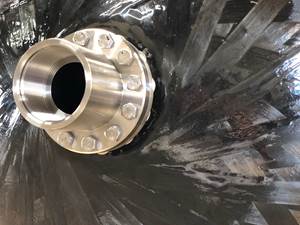Specialty graphene additives functionalize composite systems
CAMX 2024: Mito features E-Go graphene oxide for improved thermoset and thermoplastic properties, in addition to other additive solutions that are dispersible, safe to handle and scalable.
Share
Mito Material Solutions’ (Indianapolis, Ind., U.S.) E-Go product is a cost-effective functionalized graphene oxide that is added in small concentrations to current resin matrix systems to increase stiffness, fracture toughness, impact resistance, flex strength, vibration damping and thermal conductivity, among other properties.
E-Go performance benefits are achievable in thermoset and thermoplastic systems. It is designed to be a highly versatile material that integrates easily into current processes such as shear mixing powder into liquid resin, compounding powder into thermoplastics or solvent-based spray application to prepreg. According to the company, E-Go dispersions remain stable due to the functionalization of its graphene oxide.
The Mito family of specialty additive products, in addition to E-Go, include Ligra (water-soluble graphene-based binder) and ACRE (cornstarch-based additive that promotes adhesion and improves flex, tensile and impact properties in plastics). All of Mito’s products are reported to be easily dispersible, safe-to-handle, scalable solutions.
Mito E-Go is commercially available with secure scalable supply capability. TriiSO (Del Mar, Calif., U.S.) distributes the additive product to U.S. customers. TRiiSO has more than 1,800 products supplied by a diverse principal base, including a broad range of resins; curatives; accelerators/catalysts; novel flame retardants; toughening additives; and defoaming/deaerating and wetting additives for thermoset and thermoplastic resin matrix systems. TRiiSO also provides application data and formulation/lab support from 14 chemistry/application experts located across the U.S. The distributor has 13 strategically located U.S. warehouses offering supply of raw materials, with low risk of supply interruption.
TRiiSO’s primary goal has been to add innovative new materials to its portfolio of chemical solutions. Adding Mito increases TRiiSO’s product options for applications in composites, plastics, paint, coatings and ink, adhesives and sealants, and lubricants.
Related Content
-
Composites end markets: Batteries and fuel cells (2024)
As the number of battery and fuel cell electric vehicles (EVs) grows, so do the opportunities for composites in battery enclosures and components for fuel cells.
-
VoxelMatters report reveals top companies in composites AM
The new market study identifies key players in a $785 million global market that has grown by 21% year on year.
-
Graphmatech launches Aros polyamide-graphene for Type 4 tanks, secures grant
Combination of polyamide grades and graphene introduces low-permeation solution for upscaling H2 storage, transport applications.
Related Content
Composites end markets: Batteries and fuel cells (2024)
As the number of battery and fuel cell electric vehicles (EVs) grows, so do the opportunities for composites in battery enclosures and components for fuel cells.
Read MoreVoxelMatters report reveals top companies in composites AM
The new market study identifies key players in a $785 million global market that has grown by 21% year on year.
Read MoreGraphmatech launches Aros polyamide-graphene for Type 4 tanks, secures grant
Combination of polyamide grades and graphene introduces low-permeation solution for upscaling H2 storage, transport applications.
Read MoreInfinite Composites: Type V tanks for space, hydrogen, automotive and more
After a decade of proving its linerless, weight-saving composite tanks with NASA and more than 30 aerospace companies, this CryoSphere pioneer is scaling for growth in commercial space and sustainable transportation on Earth.
Read MoreRead Next
Mito to introduce graphene to EV energy storage innovations
Project initiatives for a multifunctional adhesive and addressing EV battery challenges are expected to change the dynamics of energy storage adoption.
Read MoreGraphene Composites announces approval of Heat Management Systems patent
Thermal management patent describes an engineered, potentially self-powered nanomaterial design that could efficiently transfer thermal energy to better protect vehicle applications.
Read MoreAll-recycled, needle-punched nonwoven CFRP slashes carbon footprint of Formula 2 seat
Dallara and Tenowo collaborate to produce a race-ready Formula 2 seat using recycled carbon fiber, reducing CO2 emissions by 97.5% compared to virgin materials.
Read More










